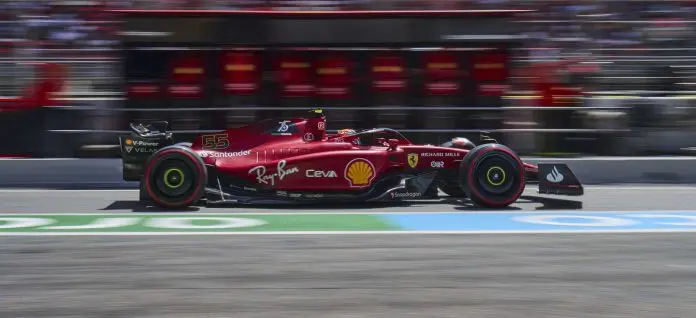F1 2022: the FIA notice dated June 16, regarding the measures that will be adopted to mitigate the porpoising phenomenon, has raised a foreseeable fuss of controversy. The noble intent to safeguard the health of the drivers made it necessary for the FIA to intervene, in light of the “inability” of many teams to remedy the dangerous vertical oscillations of their cars.
It is not the first time that the Federation has issued directives of a technical nature in the middle of the season. Just think of the 1994 season, when all F1 cars were forced to open slits in the airscope to reduce the flow of air towards the aspirated engines, after the tragic events of the Imola GP. The turmoil in the paddock is at the highest level as the FIA directive sets a dangerous precedent.
The (few) teams that have developed cars free (or almost) from vertical oscillations, see this provision as a “lifesaver” for teams unable to solve this side effect independently. Basically, the concern of the such few teams lies in the fear that the good job they had done until now will be sacrificed by flawed projects.
FormulaUnoAnalisiTecnica is staying true to its mission of “exploring” the technological aspects of the highest category of motorsport and will therefore describe the reference context and the possible scope of applicability of the recent provision issued by the FIA.
F1: Reference technological context – AS-IS
Currently, each single-seater houses between 150 and 300 sensors that generate millions of data every race weekend. In numerical terms, 300 to 400 GB are generated over a weekend in the form of data for each individual car. The following infographic lists the main sensors present on the F1 cars and the relative measured quantity.
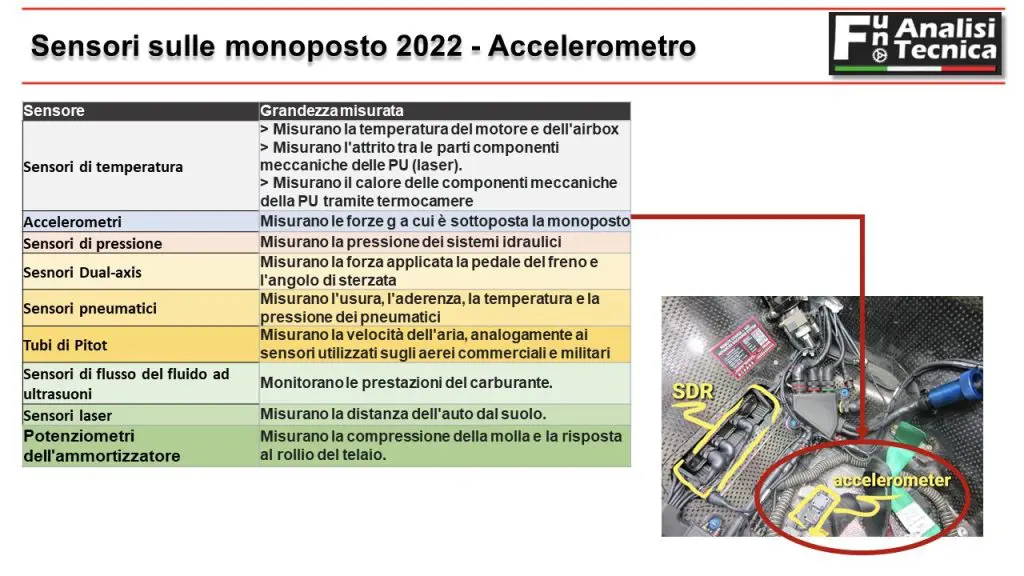
The management of such evidence creates an enormous amount of work. It is a demanding task that requires the most advanced technology for data collection, their safe storage and external communication to the respective remote garages. Much of this information is also stored on the Safety Data Recorder (SDR) control unit to which the International Federation has access.
By analyzing the data stored in the b, the FIA can check whether the components of the single-seaters have worked in compliance with the set parameters. For several years now, a sensor called an accelerometer has been present on Formula 1 racing cars, capable of detecting lateral, frontal and vertical accelerations to which single-seaters and drivers are subject.
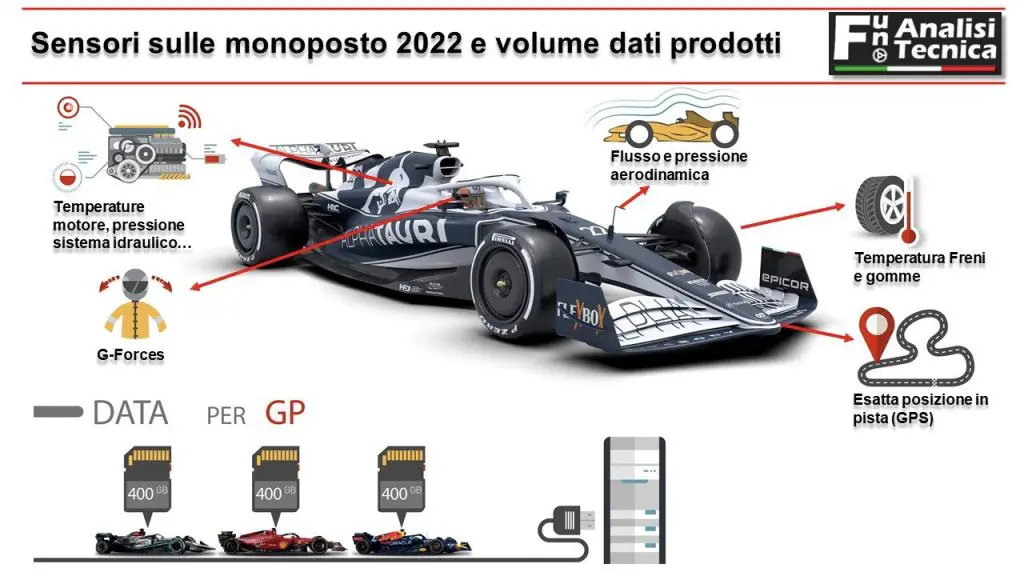
Thanks to the accelerometer, the federal technicians and are able to monitor the amplitude of the vertical pumping from the inaugural Bahrain Grand Prix. Such phenomenon, during the past few years, was perceived by the drivers only across the Eau Rouge at Spa-Francorchamps .
More and more frequently, the techs illustrate different graphic talks relating to the amplitude of the aerodynamic pumping of each single-seater. This is the mere graphic processing of the data detected by the accelerometer.
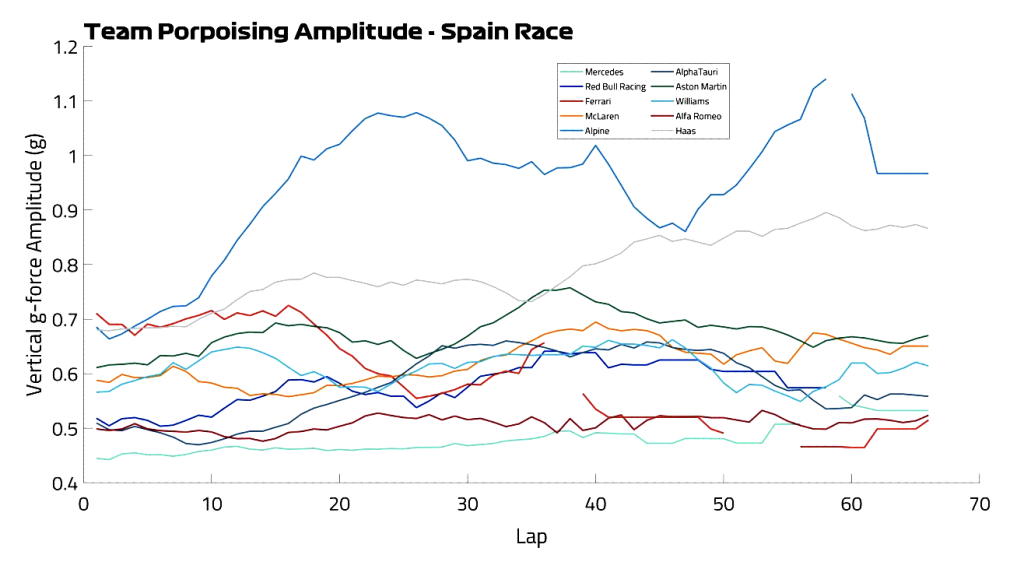
The representation above shows the peak of the vertical acceleration suffered by the car and the driver at each lap of the track. However, the data logs contain the value of the vertical acceleration of the cars at every single point of the track.
In particular, in the previous infographic relating to the Spanish Grand Prix we can see the absence of porpoising on the Mercedes W13 in relation to the particular road surface of the historic Catalan circuit, which does not display any roughness or dips.
F1 2022: defining the “acceptable level” of vertical oscillations
Having ascertained the existence of the necessary sensors on board the car, the next step is to define a range of vertical oscillations that can be considered acceptable to protect the health of the drivers. This is the most delicate aspect as the metric that will be adopted could upset the balance of forces already defined in the first nine stages of the 2022 season.
It is important to underline that the phenomenon does not occur only on long straights. For example, in the fast stretch between turn 12 and turn 15 of the Baku City Circuit, the Mercedes alone accused disproportionate porpoising compared to the competition. The simplest solution would be to impose on all teams a “Vertical G-force range” similar to the previous generation F1.
The accelerometer has been present on single-seaters for years and it would be no difficult task for the FIA to set an interval equal to the minimum and maximum excursion of the racing cars 2021. This provision would force the teams to make changes to the setup of their cars, damaging significantly those who have designed “not jumping” single-seaters, in favor of those who have not managed to solve a problem that emerged on the first day of the pre-season tests in Barcelona.

However, any other range set by the federation would be subject to harsh criticism. Just think of the Ferrari F1-75 which, despite showing an accentuated pumping, is still the reference single-seater in terms of pure single lap performance.
It is evident that the definition of a G-vertical interval that takes into account a small margin of oscillation would create big problems for Mercedes and Ferrari. Despite the opposite performances on the track, the historic Italian team and the silver arrows coexist with the pumping from the beginning of the season.
The possible choice of the Federation through stringent stakes on the vertical acceleration of the vehicle, as mentioned, would involve the adoption of arrangements that would degrade the benefits deriving from the ground effect. However, reducing the bouncing through the imposition of absolute and transversal parameters, such as the definition of a minimum height from the ground, would be an unpopular and unsportsmanlike choice.
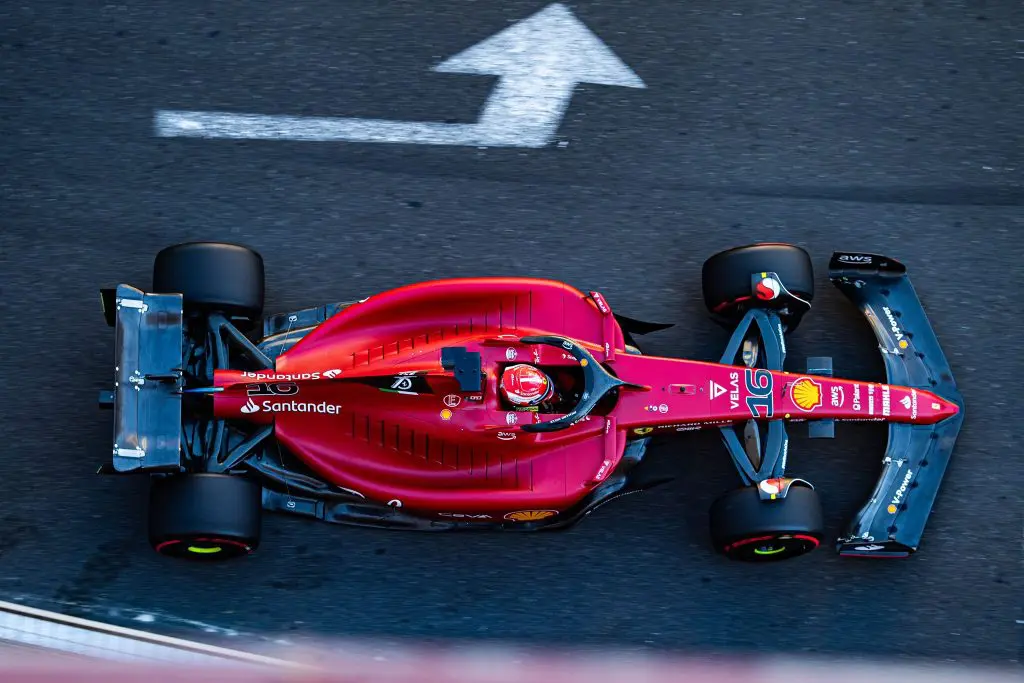
A further scenario could envisage an increase in derogation of the budget cap for the sole resolution of porpoising, to be reported promptly to the federation itself. As underlined by Christian Horner, this action would put the technical sectors with their backs to the wall which, after months, have not yet been able to solve the problem.
An option that is too difficult to put into practice and which in any case would be opposed by many teams, Red Bull above all. In a sea of question marks, the only certainty emerges: any measure imposed by the international federation will in any case be followed by controversy and a significant change in the pecking order the track.
Author and graphics: Roberto Cecere – @robertofunoat
Translation by: Beatrice Zamuner – @ZamunerB

